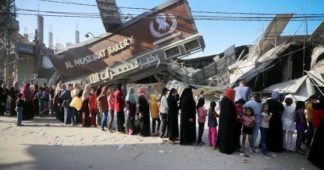By Abdaljawad Omar
Aug 8, 2025
Israel’s latest plan to occupy Gaza City reveals that the assault on Gaza is more than just a war over territory. It is a war to extend, suspend, and dictate the tempo of killing and destruction – to exhaust Gaza into submission.
It appears that Israel has descended into a state of unrestrained hubris—relentlessly inaugurating and re-inaugurating military campaigns in Gaza, each one collapsing into the next in an almost mechanical cycle, as though strategy itself has been subsumed by the imperative to project force without respite. Since the genocide’s inception on October 7th, these have included a succession of named operations—Iron Swords, Guardian of the Walls, Shield and Arrow, and Gideon’s Chariots—each framed as a discrete phase but unified in their genocidal logic and cumulative devastation. One need only look to the manifold and vile forms through which Israel enacts its daily massacres in the Gaza Strip: massacres at aid distribution sites, massacres executed through standoff fire, and massacres wrought from the air.
Yet these acts of violence unfold not only across space, but within a carefully controlled temporal horizon. The longer Israel’s operations persist, the more Gaza’s homes are reduced to rubble. The extensive use of bulldozers and the wholesale destruction of entire districts have already transformed vast areas into wasteland, yet, in Israel’s calculus, much remains to be done. This relentless devastation is not incidental—it is woven into the very logic of the war, a war narrated in the grammar of space: “phases” and “sectors,” “secured” streets, and deliberate advances southward.
But beyond this spatial choreography lies a deeper asset: time. More than a war over territory, the assault on Gaza is a war over the capacity to extend, suspend, and dictate the tempo of killing, destruction, and the planned concentration of Palestinians into the dystopian “humanitarian” city in Rafah. Time is the most valuable strategic resource—the medium through which genocide is administered and normalized. It is the time of horror that Palestinians are forced to endure; the drawn-out time of malnutrition and deprivation; the slow, grinding erosion of social bonds and moral life, as people are made to live within a permanent state of bare survival.
The Israeli campaign in Gaza rests on a fault line between two distinct logics. On one side stands the military’s spatial logic: a machinery of seizure and control, plotted on maps, measured in “secured” sectors and captured cities—a logic of closure, in which operations conclude, objectives are ticked off, and territory is marked as taken.
On the other side is the political imperative to prolong the war’s temporal horizon: to wield time as a weapon, stretching the conflict to exhaust Gaza’s population, dismantle its infrastructure, and normalize the conditions for ethnic cleansing. Here, “victory” is not defined by territorial gain but by the slow grind of attrition, the deliberate suspension of resolution.
These logics pull in opposite directions. Spatial conquest demands finality; temporal domination thrives on delay. The result is friction: operational clarity dissolves, objectives become vague, metrics of success opaque, and campaigns are redeclared without resolution. Gaza becomes a battlefield without an endpoint, where each territorial gain is folded back into the political calculus as a pretext for further destruction. In this configuration, time is both an instrument and an obstacle—a resource to be exploited, and a drag on the very closure the military machine is designed to achieve. It is therefore unsurprising that Israel’s own military leadership has pushed back against prolongation, with leaks indicating that the army’s chief of staff opposes the plan to occupy Gaza City.
Moreover, time is the currency of Prime Minister Netanyahu’s political management—both of his fractious coalition and of Israel’s volatile internal landscape. By prolonging the war, he secures the space to push through a legal coup at home, sideline the old security establishment, and radically, perhaps irreversibly, reshape Israel’s institutions. The temporal extension of the Gaza assault thus serves not only the military campaign but also the Prime Minister’s larger project of remaking the state—and of shielding himself from mounting legal troubles and corruption charges. Time, then, grants the Prime Minister respite—political room to consolidate and expand his powers—while offering his right-wing flank the opportunity to pursue its ultimate objective: the cleansing and emptying of the Gaza Strip of its people.
Such a politics of delay cannot stand without a politics of ambiguity. The refusal to define fixed objectives, or even to articulate what “victory” might mean, is not a lapse in planning but the very method by which the war is sustained. Ambiguity becomes the architecture that holds the temporal horizon open, an ally to those who perfect the art of deferral, enabling a war without conclusion and a violence without end. It is also the veil that spares Israel the burden of speaking aloud what the International Court of Justice and the International Criminal Court already suspect: that the enterprise in Gaza bears the structure of genocide, the lineaments of ethnic cleansing. Thus, as the world scrambles to imagine a “day after,” Israel releases justifications that shift like sand: the war is to bring the captives home. No—to force Hamas into surrender. No—to ensure Gaza can never again pose a threat. No—to “encourage” Palestinians to leave. Nowhere is there a measurable metric by which the war might be concluded, no definable end that mediators could seize upon to draft agreements capable of producing a ceasefire or a political grammar other than annihilation.
The newly approved plan to seize Gaza City emerges directly from this architecture of evasion—a material translation of ambiguity into policy. On August 8, 2025, the security cabinet instructed the army to “prepare for taking control” of the city, presenting it as the opening phase of a possible full occupation. Yet Netanyahu, speaking to Fox News, insists Israel “does not want to keep” Gaza, promising instead to hand it to Arab forces who have already refused to enter under the shadow of Israeli occupation. Here the contradiction is laid bare: the right to occupy asserted, the duty to govern disavowed; the power of possession claimed without the burden of administration. The plan’s declared aim of returning captives collides with the Hostages Families Forum’s warning of a “colossal catastrophe for both the hostages and our soldiers.” Netanyahu’s five principles demand the disarmament of Hamas, exclude the Palestinian Authority, and conjure an “alternative civilian administration” without naming any plausible actor. This is the deliberate construction of a vacuum: Gaza must be controlled by forces acceptable to Israel, yet no such forces exist. In that vacuum, the occupation becomes both indefinite and without governance—maximalist demands, exclusion of viable interlocutors, and cultivated vagueness composing the grammar of permanent war.
And all of this unfolds beneath the canopy of near-total impunity—sustained by the complicity of powerful allies and the quiet acquiescence of international institutions. Within this shielded space, Israel wages war as if exempt from the world’s grammar of law, as if immune to consequence, as if no tribunal could reach it. Here, the map can be redrawn, the rules rewritten, Gaza refashioned according to an annihilatory design that admits no witness and no limit. Time itself is ceded to Israel, indeed, the world gives Israel all the time it needs.
We remind our readers that publication of articles on our site does not mean that we agree with what is written. Our policy is to publish anything which we consider of interest, so as to assist our readers in forming their opinions. Sometimes we even publish articles with which we totally disagree, since we believe it is important for our readers to be informed on as wide a spectrum of views as possible.












